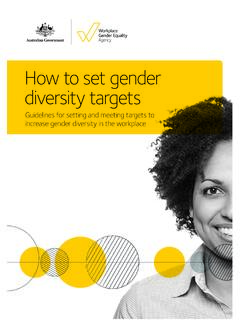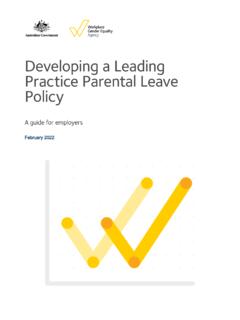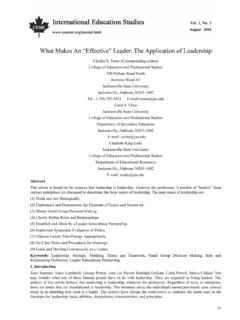Transcription of Developing a workplace gender equaltiy policy
1 workplace gender Equality Agency | Developing a workplace gender equality policy | 1 September 2014 Developing a workplace gender equality policy Organisations leading the way in workplace gender equality have in place a policy that specifically supports gender equality. This briefing note outlines the characteristics of a gender equality policy and includes measurable gender equality objectives. What is a workplace gender equality policy ? A formal policy on gender equality states the equity and diversity principles and practices applied across the employment lifecycle to support and improve gender equality outcomes in the workplace . It provides an overall framework for responsibility and accountability and may include measurable gender equality objectives. Why have a workplace gender equality policy ? A workplace gender equality policy clearly outlines the organisation s stated gender equality intent, priorities and practices. This is an important tool for communicating to managers and employees the expectations and standards to ensure that women and men are equally represented, valued and rewarded in the organisation.
2 Benefits of a workplace gender equality policy A formal workplace gender equality policy can assist an organisation to: provide both women and men access to equal opportunities and outcomes, including equal remuneration for work of equal or comparable value remove barriers to the full and equal participation of women in the workforce provide full and genuine access to all occupations, including to leadership roles for women and men drive a culture where rewards are directly linked to employee contributions and performance eliminate discrimination on the basis of gender particularly in relation to family and caring responsibilities for both women and men Meet minimum standard for employers with 500 or more staff Under the workplace gender Equality Act 2012 relevant employers are required to report against a set of six standardised gender equality indicators (GEIs). gender Equality Indicator 1 (GEI 1) relates to gender composition of the workforce and requires relevant employers to report if a formal policy or formal strategy on gender equality overall is in place.
3 Following consultation with industry, peak bodies and community groups, the Minister has set a new minimum standard as outlined in the workplace gender Equality (Minimum Standards) Instrument 2014. Leading practice snapshot: Consider the employment lifecycle to determine where equity and diversity plays a role. Consider supporting the following areas: recruitment, retention, performance management processes, promotions, talent identification and identification of high potentials, succession planning, training and development, resignations, key performance indicators for managers and remuneration. Communicate your gender equality policies to managers, particularly managers with responsibility for recruitment, performance reviews, training and development, and remuneration decisions. Communicate your gender equality policies to all employees, particularly during recruitment, performance reviews, training and development, and remuneration decisions. Ensure that the gender equality policy is consistently applied across the organisation.
4 workplace gender Equality Agency | Developing a workplace gender equality policy | 2 From 1 October 2014 relevant employers with 500 or more employees are required to have in place policies or strategies supporting one of four GEIs. GEI 1 has been set as one of four options. In addition, a strategic approach to gender equality is a prerequisite for the Employer of Choice for gender Equality (EOCGE) citation (criterion 1), and an essential underpinning for meeting other criteria. Further information on building a gender equality strategy can be obtained from the WGEA website. Features of a workplace gender equality policy It is recommended that organisations explicitly include measurable gender equality objectives in their gender equality policy . gender equality objectives may vary depending on where your organisation is on the pay equity journey. Area Key features that may be included Specific gender equality KPIs assigned to managers Overall A statement of the organisation s philosophy on valuing a diverse workforce and articulation of the benefits arising from gender equality.
5 A statement that the organisation is committed to promoting a culture that embraces gender equality at all stages of the employment cycle, particularly in the selection and assessment processes. An outline of the programs and/or initiatives that support employees with family and caring responsibilities including while employees are on parental leave. An outline of the process for correcting inequities when discovered. An explicit statement on where accountability for gender equality lies, this should include roles and responsibilities of people managers, human resources officers and relevant employees, and whether there is a gender diversity review committee. Targets to improve the balance of women and men organisation-wide and by level. Ensure at least one KPI related to gender equality is assigned to each manager. Recruitment An outline of the gender equality principles applied to the recruitment stages including but not limited to: formulating the job description, sourcing candidates and advertising, the protocol around the use of recruitment agencies, the recruitment team/panel composition and prerequisite training, the constitution of a shortlist, the interview and selection process.
6 For example: having recruitment campaigns to attract more women into a non-traditional area such as truck driving or engineering or to retain more men in non-traditional areas such as aged care or childcare including at least one female/male interviewer and at least one female/male candidate on shortlists ensuring there is a process in place to evaluate job descriptions to ensure they are relevant, include the necessary skills, are non-discriminatory and gender -neutral including a requirement for internal and external recruiting personnel to be trained in equal employment principles and anti-discrimination recruitment and selection practices having positions advertised internally and made accessible to all employees ( via an intranet, bulletin board) and using gender -neutral language in advertisements. A commitment statement to constantly review the recruitment process to eliminate bias KPIs may relate to increasing gender diversity on recruitment shortlists or on project teams.
7 Retention An outline of the gender equality principles applied to employee engagement strategies including but not limited to: remuneration, benefits and total rewards, training and development, health and safety and other employee support processes. For example: providing a keep in touch program for employees on parental level conducting skill analysis to ensure the skills of women and men are valued equally providing for training and development opportunities to be available to all workplace gender Equality Agency | Developing a workplace gender equality policy | 3 Area Key features that may be included Specific gender equality KPIs assigned to managers employees monitoring and analysing exits by gender to understand the reasons for employees staying and leaving. Performance management processes An outline of the gender equality principles applied to enhancing employee productivity, accountability and leadership including but not limited to: defining roles, responsibilities and objectives including key performance indicators, regular and recorded feedback sessions, 360 degree performance reviews and personal development plans including learning and development.
8 For example: conduct analysis of the performance ratings issued to both women and men implement a process to ensure performance standards are equitable and transparent. Promotions An outline of the gender equality principles applied to the promotion process including but not limited to: requirements for promotions (qualification, work record, success, and length of service), talent /high potentials identification, internal applications management, and support provided during the transition. For example: conduct analysis of the number of promotions for both women and men consider employees on parental leave for promotion widely advertise opportunities for promotion so as to be easily accessed by all employees throughout the organisation require managers to be trained in promotion, equal employment opportunity and diversity, transfer and termination policies and procedures. KPIs may relate to increasing gender diversity in promotions. talent identification / identification of high potentials An outline of the gender equality principles applied to the process of identifying and managing talent / high potentials internally including but not limited to: how talent / high potentials are approached internally (human resources, direct manager), how the talent pool is organised and managed (records kept, monitoring, updates), and how those individuals are involved in promotions.
9 Suggestions include: ensure women and men are represented within the talent / high potential pool identify talent / high potential in non-traditional areas conduct a skills audit across the organisation to identify high potential female and male employees who are interested in promotion (all ages). KPIs may relate to increasing gender diversity on management programs. Succession planning An outline of the gender equality principles applied to the succession planning process including but not limited to: key roles, skill retention strategies (including skills and training required), succession timetable, handover timeframe and contingency or risk management. Suggestions include: ensure both women and men are considered in succession planning for each key role ensure that succession planning is aligned with diversity and gender equality strategies. Training and development An outline of the gender equality principles applied to the availability and type of training and development programs for employees.
10 This includes but is not limited to: identification and documentation of specific employee training needs, skills gap analysis, documentation of financial resources available and utilised for employee training and development, investigation and approval of specific training programs, identification and documentation of work-related improvements achieved from training. Suggestions include: implement mentoring and / or sponsorship programs, career and leadership development programs, and project assignments in non-traditional areas for women and men conduct analysis on the number of women and men accessing training and development programs, and the type of training and development programs being workplace gender Equality Agency | Developing a workplace gender equality policy | 4 Area Key features that may be included Specific gender equality KPIs assigned to managers accessed ensure all employees have an annual career discussion with their managers that includes an annual training and development plan widely advertise training and development opportunities so as to be easily accessed by all employees across the organisation.







